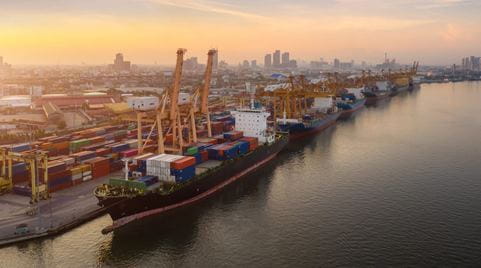Update on the situation in the Far East
We are sharing an update on the recent developments in the sea freight market, including the significant increase in the Shanghai Containerized Freight Index (SCFI) and the challenges it presents. We will also provide insight into expected trends and how they may affect your business in the coming months.

Significant increase in SCFI Index
Pressure is intensifying in the sea freight market from the Far East. This is clearly reflected by the SCFI Index, which on Friday, May 10, 2024, rose significantly across all major tradelanes. On the route between Asia and Europe, it increased by USO 569/teu, bringing it to USO 2869/teu, equivalent to USO 5738 per 40'hc. We must go back to the end of January 2024 to see such a high SCFI figure, and everything indicates that it will continue to rise in near future.
You can follow the latest updates on the SCFI Index here: Shanghai Freight Index
Multiple factors are causing pressure on the sea freight market
The very significant development in the market has caught most by surprise. The reasons for this are a mix of many factors. Shipping lines continue to be challenged by the extra capacity occupied by sailing south of Africa. This went reasonably well in March and April, which kept the rates fairly stable, albeit at a relatively high level. But things have really escalated during May. As we have mentioned before, we are experiencing increased demand, the normal summer peak has started earlier than usual.
This is a factor contributing to the pressure on the market. Significantly more vessels and thus more capacity are being used to operate a service loop due to the increased travel time south of Africa, so even though there is much talk about an incredible amount of capacity entering the market in 2024, which is quite correct, it is currently being absorbed by the longer travel time.
In fact, the weekly capacity offered from Asia to Europe is about 10% lower than the same period last year, even though significantly more vessels and thus more capacity are being used to operate a network.
Worsened congestion creates additional pressure
Congestion is making the situation worse. Perhaps the most important factor causing the pressure we are experiencing on the market is congestion at many central ports around the world. We remember this especially from the Corona pandemic as a huge challenge. We are not at the same stage as then, but it is enough to create major challenges, and we are in a bad trend where it is constantly getting worse. This creates the challenge that many vessels are delayed due to waiting time at the ports. The latest figures from Sea-Intelligence, which is an analysis institute that measures, among other things, the shipping lines' timeliness, shows that only about 37% of all vessels from Asia to Europe arrive on time, which is the lowest in more than 1 year. This is historical data, which currently only applies to March but shows the delayed effect we are now seeing, and therefore the expectation is that it will not improve in near future. We already know now that the figures for April are expected to worsen further. This not only creates great frustrations for you as customer, as your goods are delayed - but it can also contribute to what is called a "technical blank sailing". This means that a vessel, for example, on a round trip between Asia and Europe becomes so delayed that it cannot make its scheduled departure from Asia, and the shipping line is thus forced to cancel the departure, which is clearly a major challenge, as it is not a "blank sailing" decided based on low demand, on the contrary, it is typically when the market is most under pressure that this happens.
Stable rates in India and Pakistan despite global uncertainty
Rates from India and Pakistan have so far been relatively stable this May, but we often see that this market reacts with delay compared to the market from the Far East. Already now, several shipping lines have reported increases in this market from June 1, 2024. It is still too early to conclude what the outcome will be, but we may very well see increases here as well. Furthermore, we see the same trend in this market regarding delays and timeliness.
It is still very difficult to say how long this will last. In the latest update, we wrote that we expected it to cause ripples into June, but the further escalated situation suggests that it will at a minimum cause ripple into July.
We will continue to closely monitor the situation and try our best to ensure that your shipments are handled as efficiently as possible under these challenging circumstances.
If you have questions about the situation or your shipments, you are very welcome to contact your usual DSV contact person.
Haben Sie Fragen? Avez-vous des questions? Avete domande?
Our experts are ready to help. Get in touch and we'll find the solution you need.

